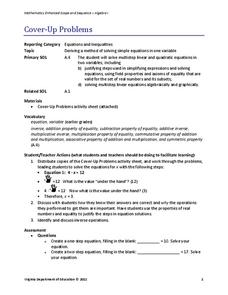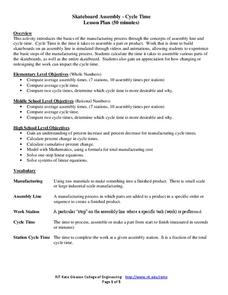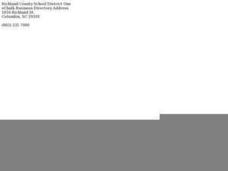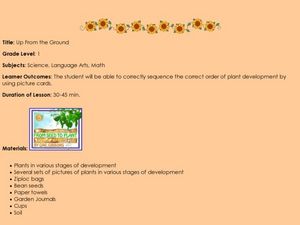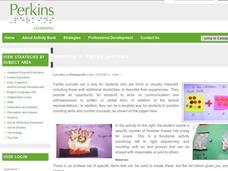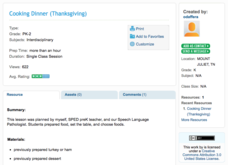Virginia Department of Education
Adding and Subtracting Polynomials Using Algebra Tiles
Scholars learn how using algebra tiles to add and subtract polynomials can model how to combine polynomials. They use their newfound knowledge to complete a worksheet of problems.
Virginia Department of Education
Transformations
The coordinate plane is a popular place! Identify rotations, reflections, and dilations on the coordinate plane. Pupils work in small groups to match transformations of a figure with the description of the transformation. They perform...
Polar Trec
Calorimetry Lab
Young people between the ages of 11–13 need on average about 2,000 calories per day. Within the lab, groups learn about calorimetry and respiration. They explore how it pertains to humans and animals living the Arctic where cold...
Virginia Department of Education
Constructions
Pupils learn the steps for basic constructions using a straightedge, a compass, and a pencil. Pairs develop the skills to copy a segment and an angle, bisect a segment and an angle, and construct parallel and perpendicular lines.
Virginia Department of Education
Cover Up Problems
Don't cover up this resource — use it out in the open! Pupils learn how to cover up various parts of a linear equation in order to help solve the equation. A worksheet of problems provides practice with this skill.
Virginia Department of Education
Circles in the Coordinate Plane
Make the connection between the distance formula and the equation of a circle. The teacher presents a lesson on how to use the distance formula to derive the equation of the circle. Pupils transform circles on the coordinate plane and...
Virginia Department of Education
Independent and Dependent Variables
Investigate the relationship between independent and dependent variables. Individuals begin by identifying independent and dependent variables from different problem situations. Then, using specific guidelines, they create posters...
Rochester Institute of Technology
Skateboard Assembly - Cycle Time
Assemble a great lesson on assembly lines. In the first installment of a nine-part technology/engineering series, future entrepreneurs learn about the manufacturing process, specifically about the assembly line and cycle time. The lesson...
Beauty and Joy of Computing
Sprite Drawing and Interaction
Discover how to program objects to move on a screen. In the second lab of a five-part unit, each learner uses block instructions to program a sprite to follow their mouse (cursor). They investigate how to use these same block...
Curated OER
The Billy Goats Gruff and the Days of the Week
First graders explore the days of the week. In this days of the week instructional activity, 1st graders listen to the story The Billy Goats Gruff, then act out the events by stepping on "rocks" that name the days of the week. Students...
Curated OER
Difference of Squares
Students analyze arithmetic statements. For this difference of squares lesson, students explore patterns and factor the difference of two squares. They compare quantities with integers. Students model and solve equations.
Curated OER
A Piece of Pi
In this piece of Pi worksheet, students examine pi. They count how many times a given digit appears in the list of digits. Students describe their observations and conclusions regarding pi. This one-page worksheet contains 6...
Curated OER
Up From the Ground
First graders sequence the development of a plant. In this plant life lesson, 1st graders listen to a story about how a plant grows, students view a PowerPoint presentation and learn new vocabulary. Finally, students sequence the stages...
Curated OER
Farm Frolics
Students learn about farms through literature and center activities. In this farming lesson plan, students read about farming, sing songs about it, sort materials, and do more activities related to farming.
Curated OER
Adding by 4's
In this add by 4 worksheet, students are given some numbers in rows and fill in those numbers that are missing in count by 4 sequences. A reference web site is given for additional activities
Curated OER
4c and 7c Stamps
Fifth graders determine what it takes for a sequence of numbers to carry on infinitely. They examine patterns that can be made using linear combinations of 4 and 7 based on the use of four cent and seven cent stamps. They use appropriate...
Curated OER
Fish Communities in the Hudson
Learning to read data tables is an important skill. Use this resource for your third, fourth, or fifth graders. Learners will will study tables of fish collection data to draw conclusions. The data is based on fish environments in the...
Curated OER
Be Sharp and Never Flat
An outstanding lesson on music awaits your young composers! They learn about patterns found in music, the different sections of an orchestra, and see the differences between musicians and a composer. Excellent streamed videos and good...
Reading for Meaning
Sample Lessons and Worksheets
If you need to bulk up your reading comprehension worksheet collection, take a look at a resource that includes graphic organizers and reading comprehension questions. The series of 50 worksheets addresses novels such as Julie of the...
Perkins School for the Blind
Counting in Tactile Journals
This is one of those great ideas I totally love. Youngsters with visual impairments practice counting and left-to -right sequencing by counting out a set number of edible objects from the left and putting them in a bag on the right. They...
Scholastic
Cooking Dinner (Thanksgiving)
American traditions of Thanksgiving come to life through culinary activities. Young chefs practice cooking a turkey and setting a table for a Thanksgiving family feast. They use math and reading skills to follow directions and measure...
Curated OER
In Touch with Apples
Students read "How To Make an Apple Pie and See the World", the story of a girl who traveled the world to find the ingredients to make her apple pie. They conduct a series of interdisciplinary activities including testing their senses,...
Curated OER
Rainbow Number Line
Guide your kindergartners to create memorable, colorful number lines that they will use throughout the school year. Using sentence strip and a black marker or card stock printed in a teachers font, create traceable numbers from 1 to 20...
Curated OER
Sequencing the Daily Calendar
Students identify the passage of time. They also practice with basic mathematical concepts.






